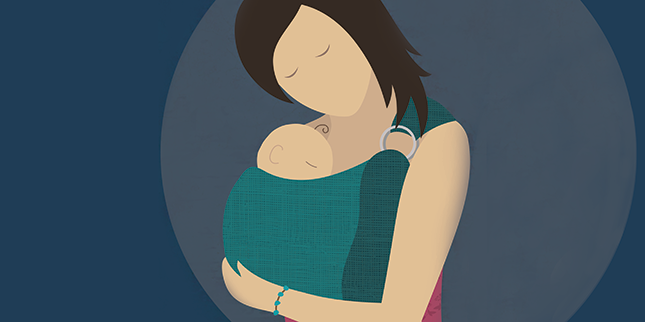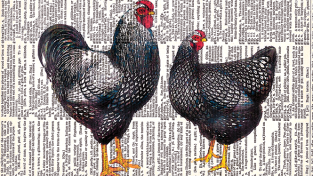The Maven: How to Wear a Baby

Illustration by NorthernSunArtPrints
Babywearing is an age-old method of caretaking, allowing a caregiver to be hands-free while meeting the needs of the child. Wearing babies is also proven to alleviate perinatal mood and anxiety disorders through improved bonding and caregiver confidence, reduced infant crying, and shared human interaction. Cultural groups around the world have worn babies for generations. In some modern cultures, babywearing practices have been lost from parenting norms, necessitating the support of babywearing groups to teach about kinds of carriers and babywearing safety. Local babywearing groups host meetings where all caregivers can come to try on carriers and receive support on how to use them.
1. Keep your baby safe
Maintaining baby’s safety is the number-one priority while babywearing. Protect a baby’s airway by keeping her face uncovered and her chin off the chest, and be sure she is close enough to kiss. Check her body positioning in the carrier to be sure that she is well supported and not slumping.
2. Choose the best baby carrier
Just a few years ago finding a carrier to fit your needs meant searching out specialty stores online, without the opportunity to try one on first. Now there are a multitude of options, which can also be overwhelming. Here are the main carrier types and why you might want to choose
one carrier over another:
- Ring slings are one-shouldered carriers constructed of a single layer of fabric with safety tested rings, perfect for young infants and toddlers who want to get up and down quickly.
- Woven and stretchy wraps are sturdy, long pieces of fabric that can be tied in a multitude of ways for maximum comfort for the wearer but have a steeper learning curve for new users.
- Buckle carriers, or soft-structured carriers, are relatively easy to use, but they are also the least adjustable. These are a good choice for older infants and toddlers, but an infant insert is recommended for newborns and young infants.
- Mei Tais have structured bodies and straps like buckle carriers but offer more flexibility and a more customizable fit, allowing multiple caregivers to use the same carrier for children of all ages.
3. Remember, everyone can wear
Babywearing is not only for parents. Wearing a child is a great way for grandparents, aunts and uncles, friends, and even older siblings to bond. Older children also like to be worn; if you are able to carry them in your arms or on your back, you can also use a carrier. Wearing a pet is also becoming more common. And, of course, as a child grows older, he may want a carrier of his own to carry dolls or stuffed animals.
—By Drew Silver Joseph ’06
 Drew Silver Joseph ’06 is an advanced babywearing educator. After struggling to conceive her son, Joseph was eager to promote bonding with her infant through the practice of holding him in a baby carrier. She sought out a group that offered peer support to caregivers. Now Joseph offers the same support as a babywearing educator and in 2014 established her local group in Madison, Wisconsin, as a chapter of Babywearing International Inc. In addition to working within her community to provide hands-on support, Joseph serves on the education and research committees with the national organization.
Drew Silver Joseph ’06 is an advanced babywearing educator. After struggling to conceive her son, Joseph was eager to promote bonding with her infant through the practice of holding him in a baby carrier. She sought out a group that offered peer support to caregivers. Now Joseph offers the same support as a babywearing educator and in 2014 established her local group in Madison, Wisconsin, as a chapter of Babywearing International Inc. In addition to working within her community to provide hands-on support, Joseph serves on the education and research committees with the national organization.
This article appeared in the winter 2016 issue of the Alumnae Quarterly.
Are you a maven?
Pitch us your area of expertise at quarterly@mtholyoke.edu.
January 15, 2016










Leave a Reply